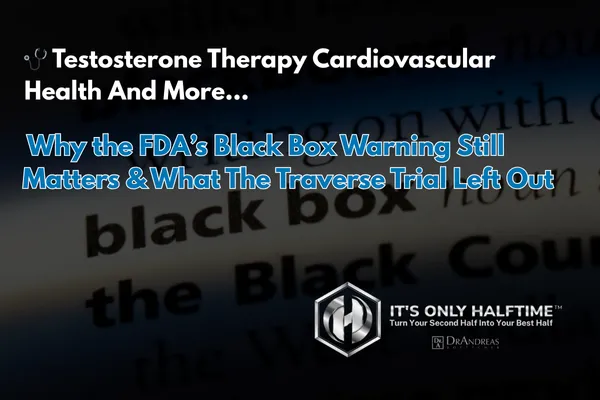
🩺 Testosterone Therapy and Cardiovascular Health: Why the FDA’s Black Box Warning Still Matters
By Dr. Andreas Boettcher, D.C., Functional Medicine, B.S. Health/Exercise Science
3x Ironman Triathlete, Master's Men's Physique Competitor, Medication FREE at 55
In 2025, the FDA removed the "Black Box" warning for TRT. Question is, was it premature?
Let's answer a question with a question.
What comes first: low testosterone or metabolic dysfunction? It’s a question at the center of men’s health today—and one that demands more than a surface-level answer.
On the one hand, low testosterone (hypogonadism) is associated with fatigue, fat gain, poor libido, and even increased cardiovascular risk . On the other, conditions epidemic in modern men—insulin resistance, visceral adiposity, and chronic inflammation—are known to suppress testosterone production at its root .
So which is the real driver? And more importantly, are you truly healthier if you artificially raise testosterone levels with injections or gels while leaving metabolic dysfunction unchecked?
The answer isn’t just academic—it carries profound implications for how men approach their health, vitality, and longevity.
📉 The False Dichotomy: Disease or Symptom?
For decades, “Low T” has been presented as a standalone condition. The fix? Weekly injections or daily gels that promise a return to youthful virility.
But evidence shows that in most men, low testosterone is rarely a primary defect. Instead, it is a downstream marker of metabolic dysfunction . The key question: if metabolic dysfunction is the root cause, is hormone replacement enough—or even safe?
🔥 The Metabolic Domino Effect
Metabolic syndrome components—abdominal obesity, insulin resistance, hypertension, and dyslipidemia—create a hormonal environment hostile to testosterone production:
Insulin resistance promotes visceral fat accumulation, increasing aromatase activity and converting testosterone to estradiol .
Systemic inflammation (elevated CRP, IL-6, TNF-α) suppresses the hypothalamic-pituitary-gonadal axis, leading to secondary hypogonadism
Leptin resistance blunts GnRH pulsatility, further lowering LH and testosterone secretion .
This cyclical decline not only depresses testosterone but accelerates cardiovascular disease (CVD), type 2 diabetes, and premature aging.
📊 The Risks of Treating Numbers Instead of Causes
Testosterone replacement therapy (TRT) is effective at raising serum testosterone levels and may improve some symptoms. But large trials raise critical questions about cardiovascular safety:
The TOM Trial (NEJM, 2010): This randomized controlled trial of elderly, mobility-limited men was halted early due to a significantly higher rate of cardiovascular events in the TRT group (23 vs. 5 in placebo) .
Observational Data: Vigen et al. (JAMA, 2013) found a 29% increased risk of MI, stroke, and mortality in men treated with TRT . Finkle et al. (PLoS One, 2014) reported a twofold increase in nonfatal MI within 90 days of starting therapy .
These findings prompted the FDA’s 2015 black box warning on testosterone products, noting that benefits and safety for age-related low testosterone were “not established” .
🆚 The Counterpoint: TRAVERSE and Emerging Data
In 2023, the TRAVERSE study challenged earlier concerns. This large RCT (5,246 hypogonadal men, ages 45–80) found no significant difference in major adverse cardiovascular events (MACE) between TRT and placebo after ~33 months (HR 0.96; 95% CI, 0.78–1.17) .
But nuance matters:
TRT was associated with higher rates of atrial fibrillation, pulmonary embolism, and acute kidney injury .
Participants were closely monitored in ways rarely replicated in real-world practice.
The follow-up period (~3 years) may not capture long-term risks of lifetime TRT use.
A 2023 meta-analysis (Alexander et al., JAMA Cardiology) reported no overall increase in cardiovascular risk but emphasized heterogeneity across studies and the need for cautious patient selection.
Which brings me to one of my biggest concerns with the Traverse study -- its duration.
The follow up period was only 3 years—really? Is three years truly enough time to draw sweeping conclusions about LONG TERM cardiovascular safety?
Cardiovascular disease isn’t an acute event; it’s a progressive, insidious process that develops over decades.
What happens after 10, 15, or even 20 years of exogenous testosterone use compared to placebo? Especially given the fact that TRT is being prescribed to younger and younger men everyday.
Those are the outcomes we don’t yet know—and they’re precisely the ones that matter most.
Not to mention, the Traverse Trial only used TESTOSTERONE GEL as it's preferred treatment.
No creams, pellets or injections were used. So the question remains, can these broad sweeping conclusions be made across all forms of TRT therapy from the use of Gels alone???
Regardless, there are still...
🧬 Mechanisms for Potential Harm
Even with reassuring data from TRAVERSE, mechanistic concerns persist:
Erythrocytosis: TRT raises hematocrit, increasing blood viscosity and thrombotic risk .
Proarrhythmic Effects: Higher incidence of atrial fibrillation (AFib) noted in TRT groups may predispose to stroke .
Blood Pressure Elevation: Testosterone can raise systolic blood pressure via sodium retention, reflected in the FDA’s updated labeling in 2025 .
Mixed Lipid Effects: TRT often lowers HDL cholesterol without improving LDL.
Not to mention a nasty side effect of making men sterile while shrinking the boys down to raisins.
🔄 The Vicious Cycle: Metabolic Dysfunction ↔ Low T
Low testosterone perpetuates metabolic dysfunction by reducing muscle mass, worsening insulin resistance, and encouraging fat gain. This creates a self-reinforcing cycle:
Metabolic Dysfunction → Low T
Low T → Muscle Loss & Insulin Resistance
Insulin Resistance → More Metabolic Dysfunction
Breaking this requires more than exogenous testosterone. It demands metabolic restoration.
✅ The Better Alternative: Natural Testosterone Restoration
At IOH, we’ve found that when men reverse metabolic dysfunction—through nutritional therapy, resistance training, mitochondrial support, stress management, and sleep optimization all based on custom lab analysis—get this right and in our experience over 80% will never need TRT.
Instead, they restore robust endogenous testosterone while improving cardiovascular markers, body composition, and energy .
This approach addresses both the symptom and the cause, reducing risks instead of compounding them.
Now, I know some will argue, “But if I feel better with higher testosterone, then I’ll have the energy to lose weight, eat better, and train harder.”
Here’s where that theory breaks down:
In my experience, as soon as men start feeling better exogenously, they simply return to the habits that got them here in the first place.
They tell themselves, “I feel fine now,” and the urgency to fix their metabolism, their lifestyle, their nutrition—it fades.
And that’s the trap.
They’ve patched the symptom but left the engine failing underneath.
📝 The Study I'd actually like to see but never will
Take one group of men and run them through our Peak Performance Protocol—fix their insulin resistance, metabolic syndrome, obesity, chronic inflammation, and visceral fat.
Transform their metabolic health from the inside out. Then compare them to a group of men on TRT who change nothing about their lifestyle.
Who do you think ends up with lower cardiovascular risk? More energy? A stronger body? A longer life?
However, you'll never see this study.
Why?
No money in it for Big Pharma. It's that simple because if they actually cared about prevention most medications would be obsolete and that's bad for business.
I don’t need a study to know the answer. I see it every single day.
📝 The Takeaway: Fix the Cause, Not Just the Symptom
The evidence is clear: metabolic dysfunction almost always precedes low testosterone.
Treating with exogenous testosterone while insulin resistance, visceral fat, and inflammation persist is like pouring high-octane fuel into a failing engine.
You may get temporary performance, but the underlying damage continues.
So the real question isn’t whether you can take testosterone. It’s whether you want to patch a symptom or truly fix the cause to even more dangerous CV risk factors than low T alone?
👉 CLICK HERE TO WATCH MY FREE MASTERCLASS TO LEARN MORE
or better yet...
⚡️ Ready To Address Root Causes With the Most Comprehensive Natural Approach to Mens Health?
If you’d like to go deeper — to uncover the root causes behind your energy, hormones, metabolism, and performance — I invite you to book a complimentary consultation.
Together, we’ll review your health history and goals and determine if our Peak Performance Protocol based on your lab analysis, genetics, and lifestyle data is right for you!
👉 Click here to schedule your complimentary consultation.
To learn more about our approach and success stories, visit www.ItsOnlyHalftime.com where we help men like you turn your second half into your best half naturally!
Finish Strong,
Dr. Andreas
Still Kickin' A** Medication Free at 55 Despite What the "Narrative" Would Like You To Believe!

Medical Disclaimer:
The information provided in this article is for educational and informational purposes only and is not intended as medical advice. It should not replace professional consultation, diagnosis, or treatment. Always consult your healthcare provider before making any changes to your health regimen or lifestyle.
References
Shores MM, et al. J Clin Endocrinol Metab. 2012.
Grossmann M, et al. Nat Rev Endocrinol. 2018.
Kelly DM, Jones TH. Clin Endocrinol (Oxf). 2013.
Dhindsa S, et al. Diabetes Care. 2010.
Kalinchenko SY, et al. Aging Male. 2010.
Tena-Sempere M. Endocr Dev. 2010.
Traish AM. J Androl. 2009.
Basaria S, et al. NEJM. 2010;363(2):109-122.
Vigen R, et al. JAMA. 2013;310(17):1829-1836.
Finkle WD, et al. PLoS One. 2014;9(1):e85805.
FDA Safety Communication. 2015; updated 2025.
Lincoff AM, et al. NEJM. 2023;389(1):20-31.
Alexander GC, et al. JAMA Cardiol. 2017;2(8):887-894.
Maggi M, et al. Eur J Endocrinol. 2016.
Corona G, et al. Eur J Endocrinol. 2014;170(5):R79-R87.
Medical Disclaimer:
The information provided in this article is for educational and informational purposes only and is not intended as medical advice. It should not replace professional consultation, diagnosis, or treatment. Always consult your healthcare provider before making any changes to your health regimen or lifestyle.


